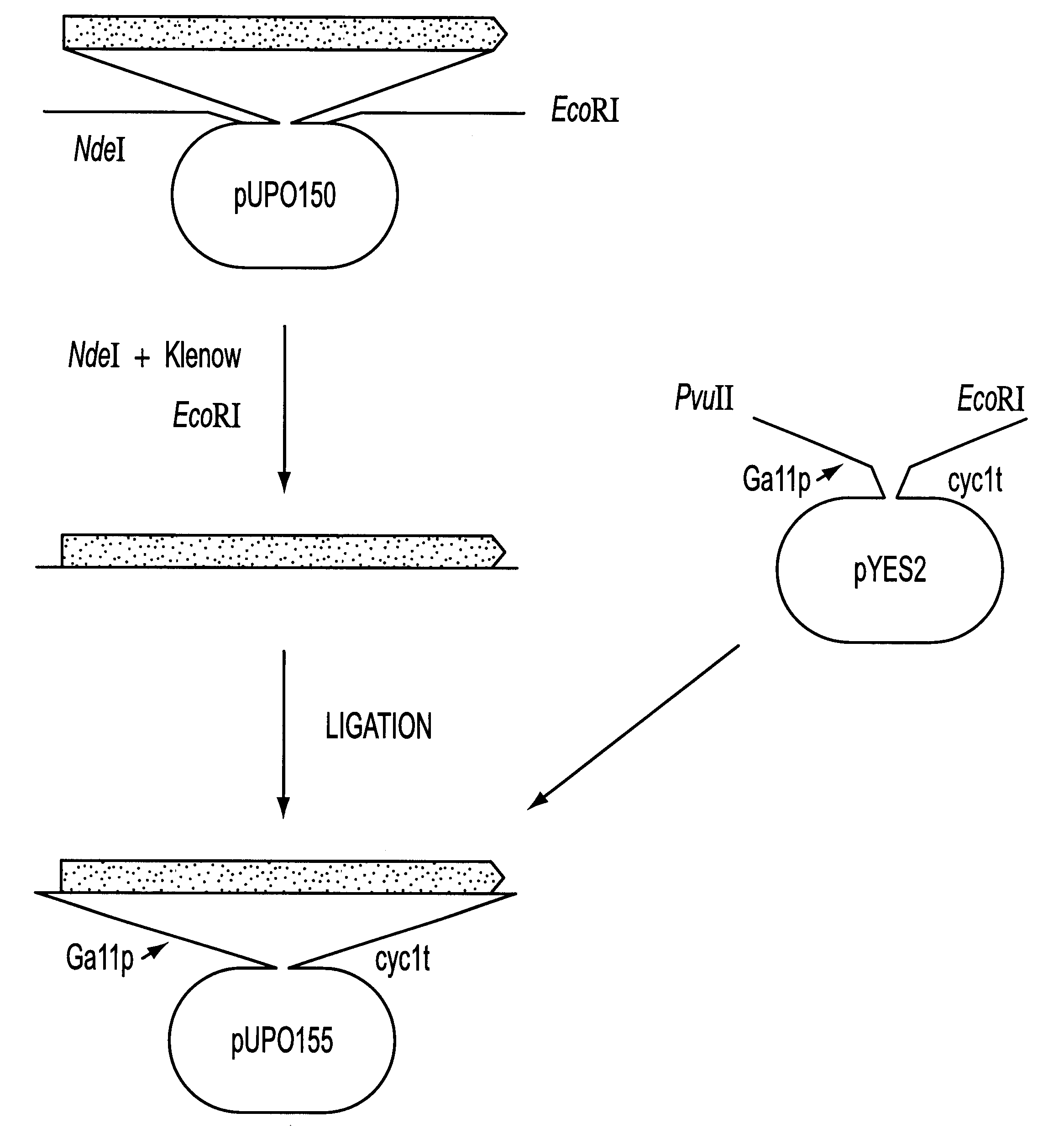Recombinant hexose oxidase, a method of producing same and use of such enzyme
a technology of hexose oxidase and hexose, which is applied in the field of recombinant hexose oxidase, can solve the problems of low glucose content in cereal flour, low glucose content in dough, and inability to efficiently acidify natural milk or dairy products, etc., to achieve the effect of reducing ph, extending shelf life of packaged foods, and reducing the ph
- Summary
- Abstract
- Description
- Claims
- Application Information
AI Technical Summary
Benefits of technology
Problems solved by technology
Method used
Image
Examples
example 1
Purification of Hexose Oxidase From Chondrus crispus
A schematic overview of the purification and two strategies adopted for obtaining amino acid sequence information for the enzyme is shown in FIG. 1.
1.1. Collection, drying and grinding of Chondrus crispus
The red sea-weed Chondrus crispus was collected during April to September at the shore near GrenA, Jutland, Denmark at a depth of 2-5 meters. Freshly collected algal fronds were rinsed with cold water and stored on ice during transport to the laboratory (<24 hours). The sea-weed was then either dried immediately or stored in frozen state until further processing. For enzyme purification the material was stored at -18.degree. C., whereas the material intended for isolation of mRNA was stored in liquid nitrogen.
Fronds of Chondrus crispus were thawed at 4.degree. C. and air-dried at room temperature (20-25.degree. C.) for 2-3 days. The dried material was ground to fine powder in a Waring Commercial Blendor (model 34BL97, Waring, New H...
example 2
Generation and amino acid sequence analysis of peptide fragments of hexose oxidase
2.1. Digestion of purified hexose oxidase with cyanogen bromide
This procedure was carried out while cation exchange chromatography on S-Sepharose was still used as the last purification step.
Hexose oxidase obtained by purification on DEAE Sepharose, Sephacryl S-200, and S-Sepharose was transferred to a volatile buffer by buffer-exchange on a pre-packed PC3.2 / 10 Fast Desalting Column containing Sephadex G-25 Superfine (Pharmacia, 0.32.times.10 cm, bed volume 0.8 ml) which was mounted in the above SMART system. The column was equilibrated and eluted with 200 mM ammonium bicarbonate (BDH, AnalaR). To obtain a satisfactory recovery it was necessary to add 500 mM sodium chloride to the hexose oxidase sample before injection.
Eluted, buffer-exchanged hexose oxidase was distributed into 1.5 ml microcentrifuge tubes and lyophilized in a Speedvac concentrator (Savant Instruments). Cyanogen bromide (CNBr, Pierce)...
example 3
Isolation of hexose oxidase gene from Chondrus crispus
3.1. Purification of RNA from Chondrus crispus
Freshly collected fronds of Chondrus crispus were rinsed with cold water and immediately stored in liquid nitrogen until further use. About 15 grams of Chondrus crispus thallus frozen in liquid nitrogen was homogenized to a fine powder in a mortar. The frozen, homogenized material was transferred to a 50 ml tube (Nunc, cat. no. 339497) containing 15 ml extraction buffer (8 M guanidinium hydrochloride; 20 mM 2-(N-morpholino)ethanesulfonic acid (MES), pH 7.0; 20 mM ethylenediaminetetraacetic acid (EDTA); 50 mM .beta.-mercaptoethanol).
The tube was vortexed and kept cold (0.degree. C.) during the following steps unless other temperatures are indicated. Then the tube was centrifuged for 20 minutes at 6,000.times.g in a Heraeus Omnifuge 2.0RS and the RNA-containing supernatant (about 15 ml) was carefully collected and transferred to a pre-chilled 50 ml tube. 1.5 ml 2 M sodium acetate, pH 4....
PUM
| Property | Measurement | Unit |
|---|---|---|
| Angle | aaaaa | aaaaa |
| Molar density | aaaaa | aaaaa |
| Fraction | aaaaa | aaaaa |
Abstract
Description
Claims
Application Information
 Login to View More
Login to View More - R&D
- Intellectual Property
- Life Sciences
- Materials
- Tech Scout
- Unparalleled Data Quality
- Higher Quality Content
- 60% Fewer Hallucinations
Browse by: Latest US Patents, China's latest patents, Technical Efficacy Thesaurus, Application Domain, Technology Topic, Popular Technical Reports.
© 2025 PatSnap. All rights reserved.Legal|Privacy policy|Modern Slavery Act Transparency Statement|Sitemap|About US| Contact US: help@patsnap.com


